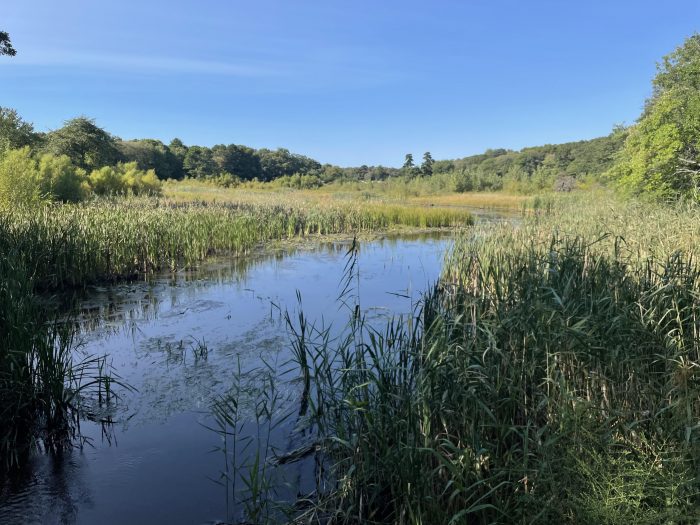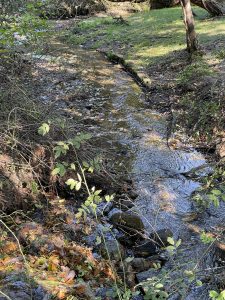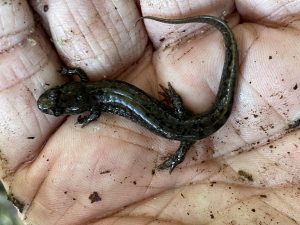Nature Matters: Conserving ‘Cutsgunsuck’

By John L. Turner
Due to the extensive development of Long Island, starting with European colonization nearly 400 years ago, virtually no species, natural area, or landscape has been untouched. Some of these “touches” have been minor, others moderate, while still others have been drastic or complete, like the virtual destruction of the Hempstead Plains, a once 40,000 square mile tallgrass prairie located in the middle of Nassau County. True too, for the timber wolf which was eradicated early in the Island’s settlement driven by a bounty paid during the 17th century for each dead wolf.
There are few places where these impacts have been more extensive than with the more than 100 streams and rivers flowing outward from the center of Long Island to the salty waters that surround it. For centuries these streams were viewed as only having commercial value; modified by dams the streams became artificial ponds to supply water for cranberry bogs and for the harvest of ice.
Mills were constructed in many places, taking advantage of the water funneled over constructed dams, to grind corn, saw wood or for fulling clothing fiber. Today, there are very few unobstructed streams on Long Island. (One of the few is Alewife Creek in Southampton which drains Big Fresh Pond, emptying into North Sea Harbor).

Obstruction is the reality at “Cutsgunsuck,” the Setalcott Indigenous Nation’s name for a “brook laden with stones,” a brook that we know today as Stony Brook. This “stone laden” brook, fed by freshwater oozing out of the Upper Glacial aquifer on its northward flow to the harbor, was drastically altered about 275 years ago, with the construction of the dam to funnel water for the Stony Brook Grist Mill so only a limited section of the original brook remains. Predictably, as with all dams, the water backed up behind the newly constructed dam, creating a pond in the process and drowning much of the stream and streamside environment — and its interwoven array of plants and animals — that had evolved in place over many thousands of years. Same was the case with the dam in Blydenburgh County Park creating Stump Pond.
Victims of these dams were the migratory fish, American Eel and Alewife, a species of river herring, that undoubtedly used Stony Brook and the upper reaches of the Nissequogue River centuries ago to spawn and develop. These fish, known as diadromous species, live in two worlds — in the case of American eels spawning in the ocean (the Sargasso Sea), migrating inland to freshwater streams, rivers, lakes, and ponds to spend more than a decade growing and maturing before returning to the ocean. Alewife behave in the opposite fashion — coming inland to spawn with the adults and young leaving to develop in the ocean.
Eels and river herring are important components of the coastal food chain, nourishing cormorants, wading birds, eagles, and ospreys while back in the sea, a host of predatory fish such as striped bass, bluefish, and tuna. Mammals that prey on these species include river otters, making a slow comeback on Long Island, and seals. The dams created insurmountable obstacles to the completion of their life cycle so for these fish and the other species that feed upon them two ecological threads were severed.

Other animals that prosper in cold and clear streams lost out too, seeing their habitat lost or substantially diminished. Remarkably, one of them is a species hanging on in the truncated stream segment south of the now drained portion of the Stony Brook Mill Pond — the Northern Dusky Salamander, an amphibian discovered by someone helping wildlife in the pond after the dam failure; a species which has not been seen on Long Island in nearly a century and was presumed extirpated here!
The northern dusky is one of nine native salamander species that call Long Island home and some naturalists wonder if this population constitutes a new species since it’s been reproductively isolated from other populations of the species, the nearest being in Westchester county, for some 12,000 to 15,000 years. DNA work is proposed to sort the genetics out.
The same adverse ecological impacts occurred when the dam was constructed to operate a grist mill at Stump Pond within Blydenburgh County Park in Hauppauge (which had its dam blow out due to the same storm event in August) but on an even larger scale. The two streams feeding Stump Pond, that is two headwater sections of the Nissequogue River, one beginning in the Hauppauge Springs area near the Suffolk County Center on State Route 454, the other emanating further afield in the Village of the Branch, disappeared with the construction of the dam that created Stump Pond, flooding many dozens of acres of riparian habitat including the killing of dozens of Atlantic White Cedar, a rare wetland tree species.
What if the dams at Stony Brook Mill Pond and Stump Pond are not reconstructed? What would this mean for the environmental setting there? Almost immediately wetland dependent plant species and wildlife would repopulate the stream and the adjacent low-lying floodplain and the wetland at West Brook in the Bayard Cutting Arboretum can provide insight. Here, the dam failed in 2019 draining an area about the size of the Stony Brook Mill Pond and naturalists have been studying the result ever since.
Migratory fish now have unimpeded access to the full length of the West Brook watershed. Plants have flourished, emerging from the seed bank that has laid dormant for many decades, awaiting just the right conditions to germinate. Within two years 108 native species of wetland-loving wildflowers began to fill in the mud banks on both sides of West Brook, including an extensive stand of cattails. These plants now support numerous insects including a number of pollinators.
Underappreciated concerns from dams and dam failures are property damage and loss of human life. These concerns are very likely to grow as the frequency and severity of storm events increases due to climate disruption.
For example, the National Centers for Environmental Information, part of the National Oceanographic and Atmospheric Administration (NOAA), keeps tallies of storms and for New York noted seven weather related disasters in the 1980’s causing $1 billion worth of property damage. By the 1990’s the total doubled to 14, the same number for the period of 2000 to 2009.
For the 2010’s? Twenty-nine such events. And in 2023 alone there were seven, the same number you’ll remember for all of the 1980’s. With slightly different circumstances it is not difficult to envision several houses and the occupants within them, living downstream from the failed dams at both the Stony Brook Mill Pond and Blydenburgh County Park, being destroyed and killed, respectively.
Then there’s the cost of maintaining dams and impoundments. The impoundments behind dams collect sediment which eventually have to be dredged, at considerable expense, or the pond becomes increasingly shallow and eventually disappears from the sediment load. And the warm, still waters in the impoundments are conducive to plant growth, especially by invasive species which often proliferate, eventually covering the entire water surface, compromising other recreational uses like boating and fishing.
For example, the Town of Brookhaven spent more than $4 million of taxpayer funds to combat Cabomba, a species of fanwort that’s a noxious weed, growing in the Upper Lake of the Carmans River (it wasn’t successful in eliminating the weed).
Suffolk County spent several million dollars more to dredge the sediments from Canaan Lake in Patchogue and Nassau County officials have committed significant staff and equipment in an effort to eradicate Water Chestnut from Mary’s Lake in Massapequa.
One last example is the state’s more-than-a-decade fight to control Ludwigia, also known as floating primrose-willow, an invasive species that’s proliferated an impoundment in the Peconic River. Multiply these fiscal impacts out to the more than 90 dams and impoundments on Long Island and pretty soon we’re talking real money. Fiscal conservatives like free-flowing conditions.
For these aforementioned ecological, public safety, and fiscal reasons, the dam at Blydenburgh County Park should not be repaired. A channel, forking from the stream currently, can be deepened to supply water to the mill wheel if the county ever makes the grist mill functioning again; it has laid dormant for nearly half-a-century.
The good news is that an alternative vision to repairing the dam at Blydenburgh County Park has emerged that would, some believe, enhance a visitor’s experience: construct a bridge over the stream where the dam gave way so hikers can once again walk around the park and the former pond and add two pedestrian footbridges over the two streams that flow through the park, providing scenic and panoramic views of the stream valleys and diverse wetland meadows that will form.
A slightly different vision can be advanced for the Stony Brook Mill Pond. Here, the Town of Brookhaven, other levels of government, and the Ward Melville Heritage Organization are moving to restore the dam, an understandable response to what the Mill Pond has meant to the local Three Village community — a landscape that’s loved and cherished.
The challenge, then, is to determine if there is a way to rebuild the dam and restore the pond but create a richer ecological setting. Can this be done? A good first step would be to incorporate a fish ladder and eel passage that effectively allows for migratory fish to access the pond; the natural-looking rock ramp fish ladder in Grangebel Park in Riverhead and the eel passage further upstream on the Peconic River serve as useful models. Also, establishing a lower pond level through a lower elevation dam would increase stream and streamside habitat for the betterment of the rare salamander and other stream dwelling species.
Two other actions that could improve conditions at the Mill Pond: 1) Soften the boundary along the eastern edge of the pond by removing the bulkheading encompassing much of the shoreline here, planting this transition area with native wetland plants and wildflowers, and 2) Better control road runoff into the pond from Main Street.
A recent conversation I had with someone who assisted in the effort to free stranded wildlife said she noticed an oil sheen on the surface of the remaining pooled water in the southeastern section of the pond where a drainage pipe empties into the pond from Main Street; a number of ducks were swimming around in this water. On a recent visit, I noticed a few ducks preening and wondered if they weren’t ingesting toxic oil into their bodies in the process.
If we embrace the alternative described above, a better experience can be had at Blydenburgh County Park and if we make these modifications, a better, more environmentally sound Stony Brook Mill Pond can emerge from the ruins, to once again be enjoyed and valued by the local community. Here, these elements would create enhanced wetland habitat for the betterment of many of our wildlife neighbors — fish, birds, and salamanders alike. And in no small measure, it would allow for the landscape feature that gave the community its name —Stony Brook — to be enhanced and better protected. Indeed, we’d be putting a bit of the “brook” back in Stony Brook.
A resident of Setauket, author John L. Turner is a naturalist, conservation co-chair of the Four Harbors Audubon Society, and Conservation Policy Advocate for the Seatuck Environmental Association.






